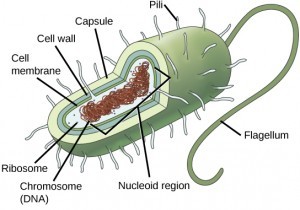Eukaryotic and prokaryotic cells represent the two fundamental types of cells found in living organisms. While both share basic cellular components, significant differences in their structure and organization distinguish them. Understanding these differences is crucial to grasping the diversity and complexity of life. This article will delve into the key distinctions between a typical eukaryotic cell and a prokaryotic cell.
Key Structural Differences: Presence of a Nucleus and Organelles
The most defining characteristic separating eukaryotes and prokaryotes is the presence of a true nucleus. Eukaryotic cells, meaning “true kernel” or “true nucleus,” house their genetic material (DNA) within a double membrane-bound nucleus. This nucleus acts as a control center, regulating gene expression and protecting DNA integrity. In contrast, prokaryotic cells (“before nucleus”) lack a nucleus. Their DNA resides in a less organized region called the nucleoid, which is not enclosed by a membrane.
Beyond the nucleus, eukaryotic cells possess a variety of other membrane-bound organelles, specialized compartments that perform specific functions. These organelles include mitochondria (energy production), endoplasmic reticulum (protein and lipid synthesis), Golgi apparatus (protein modification and packaging), lysosomes (waste breakdown), and vacuoles (storage). Prokaryotic cells lack these specialized compartments. Their cellular processes occur within the cytoplasm, a gel-like substance filling the cell.
Cell Size and Complexity: Surface Area to Volume Ratio
Eukaryotic cells are typically significantly larger (10-100 µm) than prokaryotic cells (0.1-5.0 µm). This size difference necessitates structural adaptations in eukaryotes to facilitate efficient transport of nutrients and waste products. The increased surface area provided by internal membranes of organelles helps overcome the limitations imposed by a larger cell volume. Prokaryotic cells, due to their smaller size, rely on simple diffusion for nutrient uptake and waste removal.
Cell Wall Composition: Peptidoglycan vs. Other Materials
While both cell types can have a cell wall, their composition differs. Most bacterial prokaryotes possess a cell wall made of peptidoglycan, a complex polymer of sugars and amino acids. Archaeal prokaryotes have cell walls composed of various other materials. Eukaryotic plant cells have cell walls made of cellulose, a complex carbohydrate, while fungal cell walls are often composed of chitin. Animal cells lack a cell wall altogether.
Evolutionary Significance: Prokaryotes as Ancestors
Prokaryotic cells are considered to be evolutionarily older than eukaryotic cells. The complex organization and compartmentalization of eukaryotic cells likely arose from simpler prokaryotic ancestors through processes like endosymbiosis. The similarities in basic cellular components (plasma membrane, cytoplasm, ribosomes, DNA) suggest a common ancestral origin.
Conclusion: Distinct but Interrelated
Eukaryotic and prokaryotic cells represent two distinct branches of cellular life, each with unique characteristics tailored to their respective lifestyles. The presence of a nucleus and membrane-bound organelles in eukaryotes distinguishes them fundamentally from prokaryotes. However, their shared ancestry is reflected in their common basic components. Understanding the differences and similarities between these cell types is essential to appreciating the vast spectrum of biological organization and evolution.

